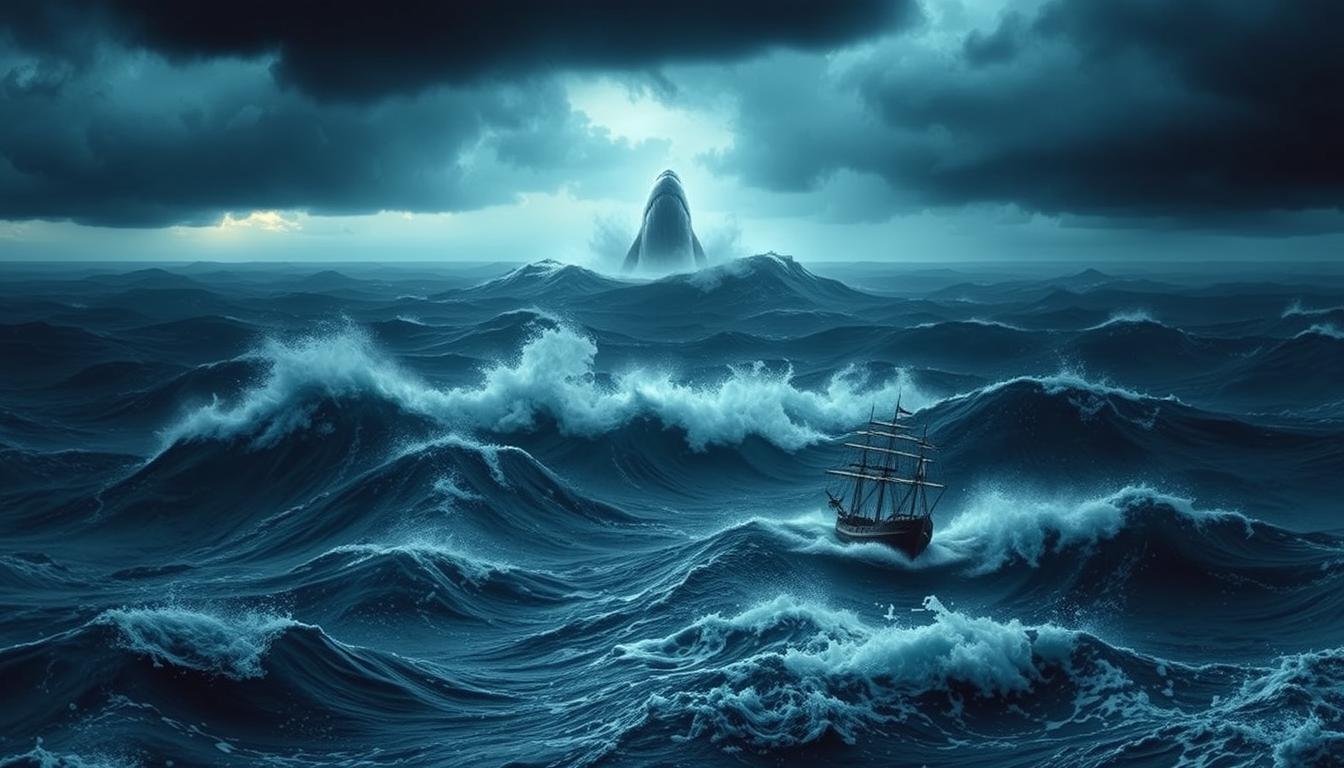Embark on a literary journey with us as we explore Herman Melville’s masterpiece, Moby-Dick, a classic novel that has become a cornerstone of American literature. Published in 1851, this epic novel continues to captivate readers with its powerful themes and unforgettable characters, including the vengeful Captain Ahab and the elusive Moby-Dick. As we delve into the world of Moby-Dick, we’ll discover the significance of this novel and its enduring appeal, making it a must-read for fans of epic narratives and sea adventures.
With its rich descriptions of the 19th-century whaling industry and the sea, Moby-Dick is a classic novel that explores the human condition, good and evil, and the power of obsession. As we navigate the complexities of Melville’s prose, we’ll encounter a diverse cast of characters, including Ishmael, Captain Ahab, Queequeg, and Starbuck, each with their own unique perspective on the world. Whether you’re a fan of American literature or just looking for a compelling story, Moby-Dick is sure to leave a lasting impression.
Key Takeaways
- Moby-Dick is a classic novel written by Herman Melville, published in 1851.
- The novel explores themes of obsession, fate, and the human condition.
- The story follows the journey of Ishmael and the crew of the Pequod as they hunt for the elusive Moby-Dick.
- Moby-Dick is a symbol of fate, nature, and the unknown, representing the forces of nature and existential questions.
- The novel is known for its rich descriptions of the 19th-century whaling industry and the sea, making it a must-read for fans of epic narratives and sea adventures.
- Moby-Dick is categorized under multiple genres, including Adventure, Drama, Fiction, and Historical, indicating its eclectic appeal to readers.
Introduction to Moby-Dick
Moby-Dick, published in 1851, is a literary masterpiece that has become an integral part of American literature. The novel tells the story of Captain Ahab’s quest for revenge on the White Whale, as observed by a seaman named Ishmael. With its complex themes and multi-layered narrative, Moby-Dick has been recognized as one of the most important novels in American literature.
The novel’s significance in American literature lies in its exploration of complex themes such as good and evil, the limits of knowledge, and the power of obsession. Moby-Dick is also notable for its blend of adventure, philosophy, and symbolism, which creates a rich and engaging narrative. As a literary masterpiece, Moby-Dick continues to be studied and admired today, offering insights into the human condition and the nature of existence.
- Its exploration of complex themes such as good and evil, and the power of obsession
- Its blend of adventure, philosophy, and symbolism
- Its significance in American literature as a literary masterpiece
Moby-Dick’s influence on American literature is undeniable, and its themes and narrative style continue to inspire writers and readers today. As a literary masterpiece, Moby-Dick remains a timeless classic, offering insights into the human condition and the nature of existence.
Herman Melville: The Author Behind the Epic
Herman Melville, a prominent figure in American literature, is best known for his novel Moby-Dick. Born on August 1, 1819, in New York City, Melville’s life was marked by his experiences as a sailor, which later influenced his writing. His early sea voyages had a profound impact on his work, particularly in his depiction of the maritime world.
Melville’s writing style was shaped by various literary influences, including Shakespeare and Hawthorne. His prose is characterized by its richness and descriptiveness, bringing to life the intricacies of 19th-century whaling and the majesty of the sea. Some of his notable works include:
- Typee (1846)
- Omoo (1847)
- Moby-Dick (1851)
- Billy Budd, Sailor
Melville’s life and work are a testament to his contribution to American literature. His unique writing style and experiences have made him a celebrated author, and his novel Moby-Dick continues to be a classic of American literature.
The Plot: A Whale of a Tale
The story of Moby-Dick is a classic marine adventure that has captivated readers for centuries. At its core, the novel follows Ishmael, a young sailor who embarks on a whaling voyage aboard the Pequod, a ship commanded by the enigmatic Captain Ahab. Ahab’s obsession with the whale Moby-Dick drives the plot forward, leading to a series of events that explore the human condition.
As the story unfolds, readers are introduced to a cast of characters, including Queequeg, Starbuck, and Stubb, each with their own unique role in the narrative. The plot is a masterful blend of action, drama, and philosophical introspection, making it a compelling read for audiences of all ages.
The novel’s exploration of themes such as obsession, revenge, and the search for meaning is woven throughout the narrative, adding depth and complexity to the story. As a result, Moby-Dick has become a timeless classic, continuing to inspire new generations of readers and writers alike.
| Character | Role in the Story |
|---|---|
| Ishmael | Narrator and protagonist |
| Captain Ahab | Commander of the Pequod and antagonist |
| Queequeg | Ishmael’s friend and harpooneer |
Themes Explored in Moby-Dick
Moby-Dick, a classic novel, is renowned for its intricate exploration of various themes that contribute to its status as a literary masterpiece. One of the central themes is obsession, as exemplified by Captain Ahab’s relentless pursuit of the white whale, Moby Dick. This obsession is driven by a desire for revenge, which ultimately leads to the downfall of the crew.
The novel also explores the theme of fate vs. free will, as characters’ choices intersect with seemingly predetermined events. This interplay is evident in the contrast between the crew’s fate and the choices made by Captain Ahab. Other significant themes include the relationship between man and nature, the limits of human knowledge, and the exploration of good and evil.
Key Themes
- Obsession and revenge: Ahab’s pursuit of Moby Dick drives the narrative and shapes the characters’ destinies.
- Fate vs. free will: The novel explores the tension between characters’ choices and the seemingly predetermined course of events.
- Man and nature: The novel highlights the complexities of the human relationship with the natural world.
These themes, among others, contribute to the novel’s enduring relevance and its status as a literary masterpiece. The exploration of these themes in Moby-Dick continues to resonate with readers today, solidifying its place as a classic novel in American literature.
Ahab’s Quest: Understanding Captain Ahab
Captain Ahab, the protagonist of Moby-Dick, is a complex character driven by an intense desire for revenge against the elusive great white whale, Moby Dick. Ahab’s obsession with the whale is rooted in a previous encounter where he lost his leg. This event has consumed his every waking moment, fueling his relentless pursuit.
Ahab’s characterization is multifaceted, with his physical appearance and psychological state both playing significant roles in shaping his persona. His relationship with the crew of the Pequod is also noteworthy, as he uses charisma, manipulation, and fear to bend them to his will. The crew’s reactions to Ahab’s quest vary, with some, like Starbuck, opposing his actions, while others, like Fedallah, seem complicit.
The themes of obsession and the destructive nature of fixation are personified in Ahab’s character. His single-minded pursuit of Moby Dick serves as a cautionary tale about the dangers of allowing one’s desires to consume their essence. The novel explores the conflict between individual will and cosmic fate, with Ahab’s quest representing the ultimate test of human determination against the forces of nature.
| Character | Relationship with Ahab |
|---|---|
| Starbuck | Opposes Ahab’s quest |
| Fedallah | Seems complicit in Ahab’s plans |
Ahab’s intentional isolation is a significant aspect of his character, embodying American Individualism. However, his connection with Moby Dick presents a break from his previous isolationism, highlighting the complexities of his personality. Through Ahab’s character, the novel explores the human condition, encouraging readers to confront the dangers of obsession and the importance of seeking deeper understanding and profound connections.
The Symbolism of the Whale
The great white whale, Moby Dick, is a powerful symbol in the novel, open to various interpretations. It represents the unknowable, the uncontrollable, and the sublime in nature. The whale’s rarity and elusive nature make it a fascinating and intimidating creature, embodying the mysteries of the ocean.
As a symbol, Moby Dick can be seen as a representation of fate, nature, and the unknown. It is a force that cannot be tamed or controlled, and its presence in the novel serves as a reminder of the limitations of human knowledge and power. The whale’s whiteness, in particular, is a symbol of purity, innocence, and terror, evoking a range of emotions and associations in the characters and readers.
The symbolism of the whale is complex and multifaceted, allowing for different interpretations and readings. Some see Moby Dick as a symbol of evil, while others view it as a representation of the sublime in nature. The whale’s significance extends beyond the novel, representing the human condition and our relationship with the natural world. Through the character of Moby Dick, Herman Melville explores themes of obsession, revenge, and the search for meaning, creating a rich and enduring literary masterpiece.
The Sea as a Setting: More than Just Backdrop
The sea plays a significant role in Moby-Dick, influencing the characters and themes of the novel. As the Pequod sails deeper into the ocean, the crew embarks on a marine adventure that tests their resolve and relationships. The sea’s vastness and power are symbolized by the whale, which becomes an obsession for Captain Ahab.
The sea’s impact on character development is evident in the way it shapes the crew’s experiences and interactions. The isolation and danger of life at sea create a unique environment that reveals the characters’ true nature. The sea’s symbolic meanings are multifaceted, representing the unknown, the sublime, and the indifference of nature to human concerns.
- The sea as a symbol of the subconscious and chaos
- The whale as a symbol of immense power and the chaotic aspects of nature
- The sea’s influence on character development and relationships
| Aspect | Description |
|---|---|
| Symbolism | The sea represents the unknown, the sublime, and the indifference of nature |
| Character Development | The sea shapes the crew’s experiences and interactions, revealing their true nature |
| Themes | The sea is connected to themes of obsession, revenge, and the human condition |
The Role of Narration in Moby-Dick
The narrative structure of Moby-Dick, a classic novel, is a unique aspect that contributes to its complexity and depth. Ishmael, the primary narrator, plays a crucial role in shaping the reader’s experience. Through his eyes, we witness the diverse crew, the perils of whaling, and the vast, unforgiving sea.
Ishmael’s perspective is that of a participant and observer, allowing him to provide a detailed and introspective account of the events. His philosophical digressions add to the novel’s thematic depth, making it a rich and thought-provoking read. The use of multiple narrative voices throughout the novel, including Ishmael’s, contributes to its complexity and allows Herman Melville to present a comprehensive view of the story’s events and themes.
Ishmael’s Perspective
Ishmael’s narrative voice is characterized by its intimacy and immediacy, drawing the reader into the world of the novel. His use of the first-person past tense creates a sense of detachment, while his philosophical musings add a layer of depth to the story. As a narrator, Ishmael is both reliable and unreliable, offering a subjective account of the events that unfold.
The Use of Multiple Narrators
Melville’s use of multiple narrative voices adds to the novel’s complexity and richness. The narrative shifts away from Ishmael’s perspective, incorporating other voices and perspectives, such as those of the crew members and the whales themselves. This technique allows Melville to explore different themes and ideas, creating a nuanced and multifaceted narrative that continues to captivate readers to this day.
Critical Reception Over the Years
As a literary masterpiece of American literature, Moby-Dick has undergone significant transformations in its critical reception. Initially, the novel was met with negative reviews, with many critics finding it difficult to comprehend due to its complex structure and philosophical themes.
However, over time, perceptions of the novel have shifted, and it is now widely regarded as one of the greatest American novels. This change in perspective can be attributed to the rediscovery of the novel by critics in the 1920s, who praised its unique narrative style and exploration of the human condition.
Evolution of Critical Perspectives
In modern times, Moby-Dick continues to be a subject of interest in academic circles, with scholars analyzing its themes, characters, and symbolism. The novel’s exploration of obsession, revenge, and the search for meaning has resonated with readers, making it a timeless classic of American literature.
The novel’s impact on American literature is undeniable, with its influence visible in many other works of literature. As a literary masterpiece, Moby-Dick continues to inspire new generations of readers and writers, cementing its place in the canon of American literature.
Academic Significance
The study of Moby-Dick in academic circles has led to a deeper understanding of its themes, characters, and historical context. The novel’s portrayal of a diverse and unconventional crew has been praised for its progressive representation of racial and social issues, making it a significant work of American literature.
Adaptations and Cultural Impact
Moby-Dick, a classic novel of American literature, has had a profound impact on popular culture. Its themes and characters have been adapted and referenced in various forms of media, from film and theater to music and marketing.
One notable example is the 1956 film adaptation directed by John Huston, starring Gregory Peck as Captain Ahab. This film, along with others, has helped to cement Moby-Dick’s place in the cultural consciousness. The novel’s influence can also be seen in other works of literature, such as Star Trek IV: The Voyage Home, which references the white whale and Ahab’s quest for revenge.
The cultural impact of Moby-Dick is further evident in its numerous adaptations and references in popular culture. Some examples include:
- Operatic and film adaptations, such as the 2010 film Moby Dick starring Barry Bostwick
- Comic and graphic novel versions, such as the 2011 graphic novel Moby-Dick by Tony S. Daniel
- References in music, such as the song “Moby Dick” by Led Zeppelin
These adaptations and references demonstrate the enduring influence of Moby-Dick on American literature and popular culture, solidifying its place as a classic novel that continues to captivate audiences to this day.
| Adaptation | Year | Medium |
|---|---|---|
| Moby Dick (1956 film) | 1956 | Film |
| Moby-Dick (2010 film) | 2010 | Film |
| Moby-Dick (2011 graphic novel) | 2011 | Graphic Novel |
Conclusion: The Lasting Legacy of Moby-Dick
As the epic tale of Moby-Dick comes to a close, it’s clear that this classic novel by Herman Melville continues to resonate with readers today. Beyond its thrilling whaling narrative, Moby-Dick is a profound exploration of the human condition, delving into themes of obsession, fate, and mankind’s place in the natural world.
Melville’s masterpiece has cemented its status as a cornerstone of American literature, captivating new generations with its rich symbolism and vivid imagery. The story of Captain Ahab’s relentless pursuit of the elusive white whale speaks to the deep-seated desires and vulnerabilities that drive us, even in the face of inevitable destruction. Like the vast, unknowable ocean that serves as the novel’s backdrop, Moby-Dick offers endless layers of meaning for those willing to dive beneath the surface.
In a world increasingly dominated by technology and digital distractions, the timeless lessons of Moby-Dick remain acutely relevant. Its cautionary tale of the dangers of unchecked ambition and the need to find balance between man and nature resonates with contemporary concerns about environmental stewardship and the pursuit of progress at all costs. By engaging with this literary masterpiece, readers can hone their critical thinking skills, expand their cultural perspectives, and gain a deeper understanding of the complexities of the human experience.
As we close the final chapter on Ishmael’s journey, it becomes clear that Moby-Dick is not merely a classic novel, but a timeless exploration of the human spirit – one that continues to captivate, challenge, and inspire readers across generations. Its enduring legacy is a testament to the power of great literature to illuminate the universal truths that bind us all.











